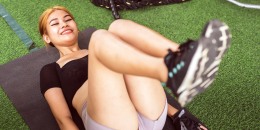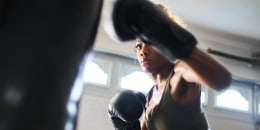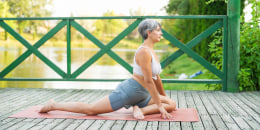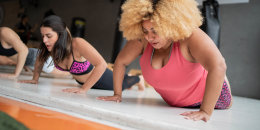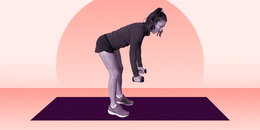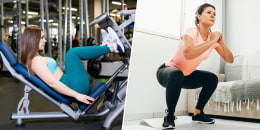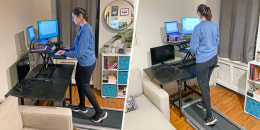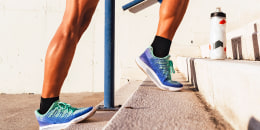For on-demand barre workouts — plus fitness challenges, meal plans and inspiration — download the Start TODAY app!
Barre is having a moment. The light-weight, high-rep style of strength training is a low-impact way to sculpt lean muscle mass and improve endurance.
But it can be intimidating to try a barre class for the first time, especially if you don’t have a dance background or are unfamiliar with the style of training. The classes bring together elements of dance, Pilates and yoga for full-body strength training that truly is for all fitness levels.
“We target each major muscle group at a time, working with high repetition and light resistance, so we fatigue each muscle group. And then we combine some stretching in between each section of work, so we’ve got flexibility, mobility and strength training in every single class,” says Katelyn DiGiorgio, Pure Barre’s director of training and technique.
Learn more about the benefits of barre, what to know before your first class, and some exercises you can try at home.
The history of barre
The barre method was created by Lotte Berk, a German ballet dancer in the 1940s. Recovering from a back injury, she created the training style by fusing her dance training with physical therapy, and eventually opened a barre studio in London after fleeing from Nazi Germany, says Alexis Sweeney, a barre instructor at Equinox.
Over the years the workout evolved and while the movements you see in barre classes today are still based on postures from ballet, they are more approachable for non-dancers, Sweeney says.
Barre workout benefits
If you're looking to mix up your workout routine, barre can be a great choice for beginners and more advanced levels alike. Here are some of the health benefits you can reap from the workout:
It’s low impact and easy on the joints
Barre is a low-impact workout, making it a good workout option for people with arthritis or joint issues, those recovering from an injury or anyone who is pregnant. Because the training style uses high reps and light resistance, you are able to build muscle endurance and strength without putting too much pressure on your joints.
“It’s become a gateway into working out and strength building for a lot of people because it’s so manageable with the light weights, and you can see change in both strength and physical definition,” DiGiorgio says.
The small movements also work your body in a unique way, targeting tiny muscle fibers that may not be recruited in other strength-training routines, Sweeney says. The exercises will increase your heart rate and fatigue your muscles to the point of a quiver, or “little shake,” she says.
It helps improve posture
If you work a desk job, spend a lot of time commuting, or are mostly sedentary, barre is a great workout for the chest, shoulders and hips, which are often weakened from sitting.
“The movements focus on posture alignment while improving your core strength and the stabilizing muscles of your shoulders and hip girdles,” explains Nadia Murdock, mindset and movement coach and founder of Nadia Murdock Fit.
Barre works the core and the muscles in the chest and shoulders, “to support your back and a stronger posture,” Sweeney says. “In every single class, you will hear me say, ‘Shoulders back, chin up, and pull your navel into your spine,’ at least two or three times as a constant reminder to create as much length in your spine as you can.”
This heightened awareness around your posture will carry over to daily activities. Engaging the core and standing tall helps relieve pain in your neck, back and hips from poor posture, she says. "For someone like me with severe scoliosis, practicing barre consistently has not only re-trained my posture, but it has increased the mobility in my spine, as well as my mindfulness when it comes to how I stand and enter a room.”
It enhances flexibility and mobility
Barre exercises pack a two-in-one punch, improving our mobility while also building strength. Stretches are woven throughout a barre class to complement the strength exercises. And the strength exercises themselves challenge our mobility and help boost the range of motion in the joints and muscles.
For example, when you’re doing a wide-second position, which is like a sumo squat, you’re stretching your hips and inner thighs as you lower down into a squat, DiGiorgio says. “I love this position because you have to stand tall, engage your core, and hold your posture as you squat down. Then, you’re doing squat pulses. But while you’re building the strength in your legs, you’re also building mobility through the joints and flexibility because it requires you to stretch,” DiGiorgio says.
It supports your recovery after an injury
Low-impact exercise like barre is a great way to build muscle strength and endurance without any added impact to the body, and this is especially beneficial for those recovering from an injury. The controlled movements deepen your mind-muscle connection, which is important for training your body to move safely and help strengthen the injured area.
For instance, “if you’re in physical therapy to rehab your ankle, you’re doing a lot of exercises where you’re channeling all your brain power into various movement patterns of your ankle to try to rehab it,” DiGiorgio explains. “In a barre class, you’re drawing attention to each major muscle group and really focusing on the brain-body connection to move in a really specific and targeted way, which can be really rehabilitative.”
What to expect at your first barre class
Walking into any unfamiliar workout can be intimidating and the barre studio with a ballet barre on the wall that hints at a classical dance class is no different.
“I find that a lot of students feel they need to know everything before taking a class, which is one of the reasons why they don’t commit to taking a class," Murdock says. "Although barre may have an intimidation factor, please know that you don’t have to know everything when walking into the studio. Some of the moves you might already be doing and not even realize it!”
If you are new to barre, be sure to sign up for a beginner or intro class so you are with people at a similar level and the instructors will help you master foundational exercises. For the best results, Murdock recommends doing barre two to three times a week and weaving in other forms of exercise and rest days in between.
- Equipment: The good news is you won't need to figure out lots of complicated gear. Most barre exercises are done with your own bodyweight (in socks, so you don’t need shoes!) on a yoga mat. You may also use light weights, a Pilates ball and ring, resistance bands, yoga blocks and gliders.
- Class structure: The flow of a class will vary by studio and instructor, but generally, you’ll start with a warm-up stretch and then do some arm work, which can be done at the bar or on your mat, Murdock says. Then, you’ll do some exercises at the bar, followed by mat work, which includes ab and lower-back exercises. To finish things off, you’ll do some stretches, like pigeon pose, seated side bends, flexing and pointing toes, and a kneeling quad stretch. At Pure Barre, DiGiorgio says you’ll target each major muscle group by section, starting with core work and moving onto your arms and upper body. Then, you’ll do some stretches and transition to your lower body, and finish with more core work and stretching. This is all done in a flow.
Barre positions
Although all the exercises will be thoroughly explained during class, it’s helpful to know these signature barre positions.
- First position: Also known as a “small V,” this position involves standing tall with your hands on your hips, your heels together and your toes turned out to the sides at 45 degrees. “Be mindful of not exaggerating the turn-out and have it come from your hips,” Mudock says.
- Second position: In this position, your feet are wide apart — wider than hip distance — with your toes and knees turned out. Keep your hips aligned with your shoulders and your spine neutral so your back is straight, Murdock says.
- Tuck: Stand with your legs together, squeezing your glutes and pulling your abodminals in. This creates a slight curvature in your lower back, Sweeney says.
- Chair: Face the bar and place both hands on it. Bring your feet close together so that your ankles, knees and thighs touch. With your toes pointing forward and your heels directly behind them, bend your knees and sit your hips back as if you’re sitting into a chair. Make sure your spine is neutral and avoid arching your back, Murdock says.
Try these 3 sample barre exercises:
Want a taste of barre class at home? Here are three moves you may see in class demonstrated by Sweeney.
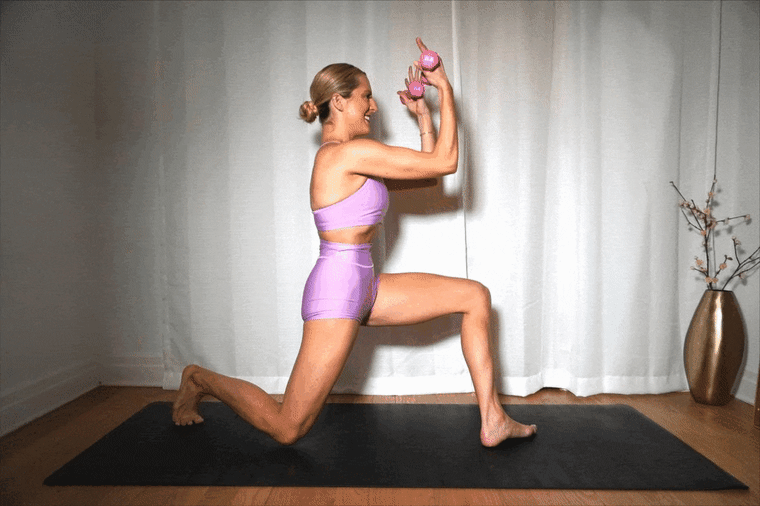
Parallel lunge pulses
Get into a lunge with your right leg forward and your left leg behind you. Bend both legs to form 90-degree angles. Hold a light dumbbell in each hand and bend your elbows at a 90-degree angle. Standing tall with your torso upright, lower your back leg down one inch while bringing the weights up in front of you so that your elbows are in line with your shoulders, then lift the back leg up one inch and return arms to your sides. Do 16 reps and repeat on the other side.
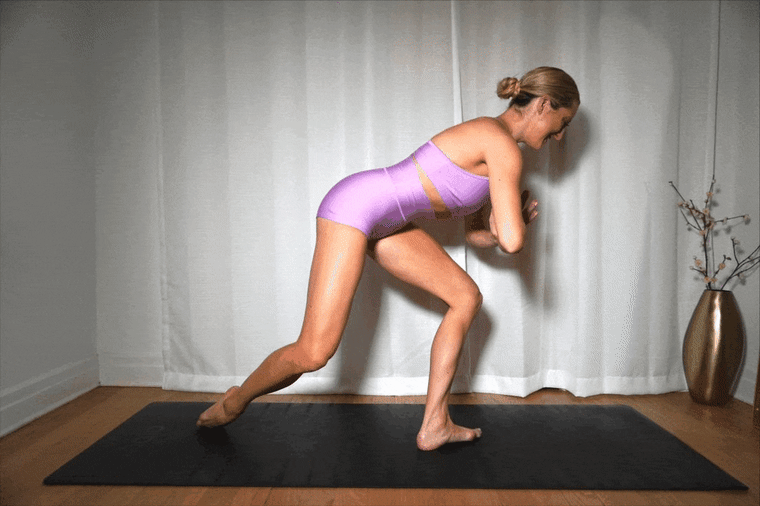
Attitude back extensions
Press your palms together in front of your chest to help engage your abdominals, and then shift your weight forward into the ball of your front foot, both legs are in external rotation (turned out). Lift your back leg toward the ceiling into an attitude bent-leg balance, and lower. This balance challenge not only activates all your muscle fibers in your front standing leg, but it strengthens your glutes and core as well, Sweeney says.
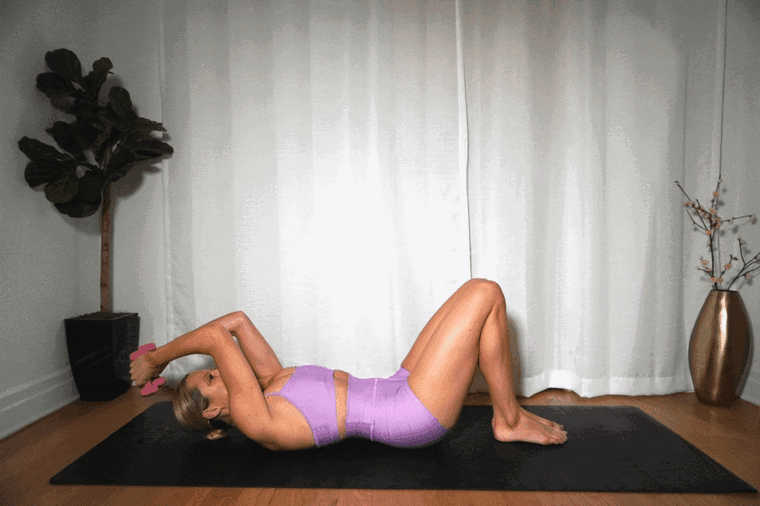
Triceps press
Lie on your back with your knees bent and feet flat on the floor, hip-width apart. Hold a light dumbbell in each hand by the sides of your head, forming 90-degree angles with your arms. Exhale as you press the weights above your chest, straightening your arms. At the same time, dig into your heels to lift your hips off the ground. This is great for strengthening your glutes, hamstrings, abdominals and triceps all in one move, Sweeney says.


